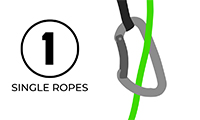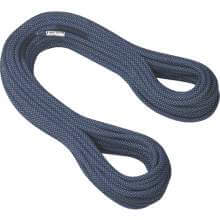9.8mm Tusk 70m Dry
Description
The Mammut rope finishing processe (superDRY™) gives the rope durability and comfortable handling. Thanks to this and the relatively small diameter of 9,8 mm, the Tusk has a very wide range of uses
Retail price
When you click a link below and then checkout online, no matter what you buy (climbing gear or not), we get a small commission that helps us keep this site up-to-date. Thanks!
| Weight | 64.0 g/m 9.876 lbs / 4480 g |
| Diameter (millimeters) | 9.8 mm |
| Length (meters) | 70 m |
Rope Type  Type
There are 3 types of dynamic ropes that are used by climbers. They are known as Single, Half (Double), and Twin. The type of rope preferred varies by climbing style, location, and region. Single
By far, the most common type of rope. Great for indoors and out. In the US, it is the most common sport and big wall and are also used for trad cragging. The handling is simple and the diameter options are quite varied. Half (Double)
The best cure for a meandering route, only one of the ropes will clip into each piece of protection so a mindful climber can can reduce rope drag considerably. You can also rappel twice the distance, it’s easier to safely protect traverse pitches and there is a smaller chance that both ropes would become damaged (by rockfall, crampons, etc). Twin
Both ropes must be clipped through each piece of protection. This is the lightest style of (two) ropes. They excel for rappels, going twice the distance vs a single rope, but do not have the ability to mitigate rope drag even though there are two ropes. It is unlikely both ropes will be damaged at once, and is why many alpine, ice and mixed climbers choose twin and/or half ropes. Learn More
Every rope type and when to use them | Single |
UIAA Falls (Single / Half / Twin)  UIAA FallsThis refers to the number of UIAA falls a rope has been tested to be able to withstand without breaking. The UIAA fall is a complicated test that is designed to create a uniform standard for strength in ropes, and is not generally reflective of real-world climbing situations. The test involves dropping a weight tied to the rope in such a way that it will see the highest amount of force a real-world situation could generate. The UIAA requires that Single and Half ropes must pass this test without breaking at least 5 times, while twin ropes must withstand 12 falls. In practice, it can likely be concluded that ropes that have higher than this standard number of falls will be stronger and put up with more abuse. It is important to note that any rope that is UIAA or EN certified is considered safe to climb on, regardless of the number of UIAA falls it is rated for. | 9 falls / - / - |
Dynamic Elongation (Single / Half / Twin)  Dynamic ElongationThis refers to the amount of stretch measured during the dynamic testing (or drop test) used when certifying ropes. Higher stretch will absorb more force and result in a softer catch but increases chances of groundfall at the beginning of a climb. The EN and UIAA require a stretch of at least 10% and no more than 40% for dynamic ropes. Single and Half ropes are tested individually and Twin ropes are tested as a pair. | 30.0 % / - / - |
Static Elongation (Single / Half / Twin)  Static ElongationThis refers to the amount of stretch measured during the static test used when certifying ropes. Most climbers will notice the difference in static elongation when climbing in a top rope situation, where higher stretch will make for a springier belay and could result in a ground fall when climbing closer to the ground. The EN and UIAA require a stretch of no more than 10% for Single and Twin ropes and no more than 12% for Half ropes. Single and Half ropes are tested individually and Twin ropes are tested as a pair. | 6.8 % / - / - |
Impact Force (Single / Half / Twin)  Impact ForceImpact force is the amount of force in kN that is measured at the testing mass during the UIAA dynamic drop rope test. When the weight is dropped, the force measured must be at or below 12kN for Single and Twin ropes and 8kN for Half ropes. The real world application of this test is determining that the rope can dissipate and absorb the appropriate amount of force from the fall as it would be felt by the climber. The variables used in the test set a situation that is well beyond anything climbers encounter, and shouldn't be considered realistic to actual climbing situations. In reality forces of this magnitude would result in severe injury as this test is designed to test the limits of the rope and not the comfort of the climber. | 8.80 kN / - / - |
Dry Treatment  Dry TreatmentWhen a rope is dry treated, it has had a coating applied to its core fibers, its sheath fibers, or both. The purpose of this coating is to reduce the amount of water the rope can absorb when in wet or icy conditions. Wet ropes are heavier, handle and belay differently, and have been tested to be weaker than dry ropes. Many climbers prefer dry treated ropes for very dusty or dirty environments, as they are more resistant to uptake of dirt and can stay cleaner longer. Learn More
Benefits of Dry vs Non-Dry ropes | Sheath only |
| Sheath Proportion (%) | 38.0 % |
| Sheath Slippage (mm) | 0 mm |
| Type of Middle Mark | None |
| Rope End Marker | None |
| Certification | CE, EN, UIAA |
RFID / NFC Option  RFID and NCFThis technology can be helpful if you are a gym or professional business where you'd like to track the usage and age of your ropes. RFID is how items are uniquely identified using radio waves (Radio Frequency Identification). It's for 1-way communication from 10cm to 100m away depending on the frequency. Example: Airport Baggage. NFC is a subset of RFID that is restrained to close proximity communication typically less than 10cm (Near Field Communication). NFC chips can operate a 2-way signal to exchange information. Example: Apple Pay. | None |
No reviews yet.
A rope is a rope, and I’m still not picky about which rope I use while climbing. As long as I can belay easy, clip carabiners quickly and not die when I fall, then the rope is good in my book. So I certainly can recommend the Mammut Tusk for anyone looking for a good, all-around climbing rope for day trips on local crags.
Good “workhorse ropes” are ones those that can take a beating but are also reasonably light for long approaches and use on big wall climbs. There are many great ropes in this category, but my favorites are the Mammut Tusk 9.8mm, the Sterling Velocity 9.8mm, and the Maxim Glider 9.9mm. These ropes have displayed great durability, have a nice “hand” (supple, smooth), and have kept me alive in many uncertain circumstances. Ropes with a diameter less than 10mm feature good balance of weight and durability, nice movement through belay/rappel devices, and a tendency of NOT breaking the bank. These ropes are most appropriate for lead climbing, but are also good for top roping so long as they are not moving across a lot of sharp edges. For people that are primarily top-roping, a thicker rope is more appropriate because there is simply more sheath to protect the core from abrasion.
The Tusk has been a consistent and steady performer. Its 9.8 mm diameter is about as thin as I’m comfortable with for all of my falling and hang-dogging. The rope’s medium rigidity makes it just average at clipping to carabiners; yet also seems to yield a fluffy-soft catch.
Lap Coiling rope-packaging machine means no factory kinks in cord.
SuperDry treatment: A coating to both sheath and core, this gives a smooth feed and added protection. A bit slippery at first.
Comes in two colors: yellow and lime green. The yellow one, which I tested, seems to pick up a lot of dirt and now looks black.
9.8 mm. A good combination of lightness (63 g/m) and durability (6-7 UIAA falls). The speed that the sheath has frayed from normal wear has been just average.
Recommended uses: sport climbing, trad climbing, alpine rock climbing.
This video shows all the features of Mammut ropes.



